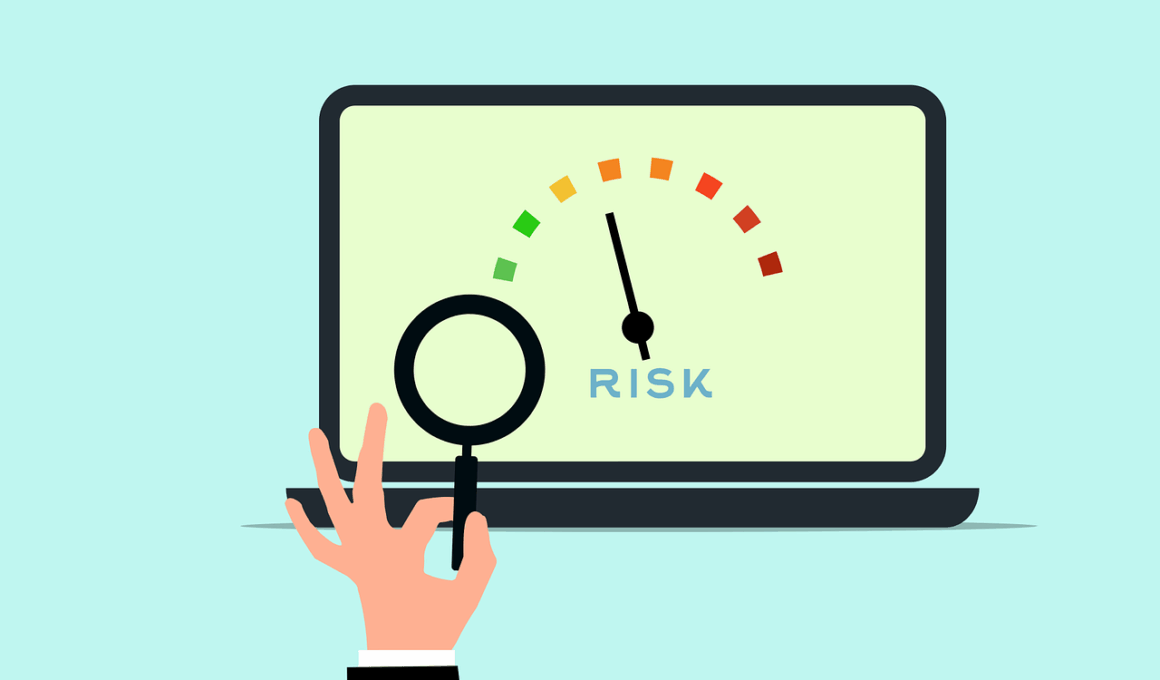The Intersection of Financial Technology and Risk Management
The convergence of financial technology and risk management is crucial for modern financial institutions. As firms adapt to rapid technological advancements, risk management practices must evolve. This intersection allows organizations to harness data analytics, artificial intelligence, and machine learning. These tools streamline risk assessments and enhance decision-making processes. Moreover, adopting specific technologies can identify potential risks before they materialize. Tools such as predictive analytics play a significant role, enabling institutions to anticipate market fluctuations. Therefore, companies must invest in technology that supports efficient risk management strategies to stay competitive. Collaboration between tech and finance professionals ensures that innovative solutions address actual financial risks. Financial regulations often lag behind technological advancements, creating a knowledge gap that organizations must address proactively. Regulations now often encourage better risk management practices, emphasizing the need for digital solutions. Organizations embracing this change can enhance compliance with evolving regulations while mitigating uncertainties. Ultimately, the methods deployed for integrating technology into risk management can lead to more resilient financial systems, providing stakeholders with confidence in financial practices.
Understanding the various types of risks that organizations face is essential in implementing effective risk management strategies. Financial technology fosters an environment conducive to identifying, categorizing, and mitigating these risks. Key risks include market risk, credit risk, operational risk, and liquidity risk. Each category requires unique approaches for assessment and management. Market risk arises from fluctuations in asset prices, while credit risk concerns borrowers’ capacity to repay debts. Operational risk stems from internal processes or systems failing, impacting business operations. Conversely, liquidity risk relates to the inability to meet short-term financial obligations. Financial institutions leveraging technology can implement real-time monitoring systems to track these risks effectively. Automated tools can analyze large volumes of transactional data, identifying patterns and abnormal behaviors. Data visualization techniques enhance the clarity of these analyses, making it easier for decision-makers to understand risk profiles. Furthermore, organizations can use scenario analysis to anticipate potential adverse developments and devise response strategies. Overall, technology empowers firms to respond swiftly to diverse risks, enhancing their ability to navigate an increasingly complex financial landscape.
Enhancing Data Analytics for Risk Management
Data analytics is a cornerstone in integrating financial technology with risk management. Advanced analytics can transform vast amounts of data into actionable insights, significantly improving risk assessment accuracy. Financial institutions often deal with extensive datasets from various sources, necessitating effective tools to analyze this information. Implementing machine learning algorithms allows organizations to recognize patterns and trends that traditional methods might overlook. Predictive modeling offers the ability to forecast potential risks based on historical data, enabling proactive measures. Furthermore, deploying big data analytics facilitates real-time risk identification, allowing for rapid responses to market changes. A strong risk management framework harnesses these capabilities, ensuring that organizations remain agile and resilient. Combining data analytics with visualization tools enhances the communication of risk status to stakeholders, fostering a culture of transparency. Moreover, continuous advancements in data privacy regulations necessitate robust data management strategies. By prioritizing analytics in risk management, financial institutions can create a holistic approach that not only mitigates risks but also supports informed decision-making processes across departments, contributing to overall organizational stability.
Another critical aspect of integrating financial technology and risk management is compliance with regulatory requirements. Financial institutions face an ever-evolving landscape of regulations aimed at ensuring systemic stability and protecting consumer rights. Compliance risk remains a significant consideration for firms as regulatory expectations grow. Technologies such as RegTech—short for regulatory technology—specifically aim to address these challenges. These technologies streamline compliance processes, automating reporting and monitoring in real-time. They also enable firms to adapt swiftly to changes in regulation, minimizing the risk of penalties or legal repercussions. By harnessing automation, organizations reduce human error and operational inefficiencies, significantly enhancing compliance. Additionally, leveraging data analytics helps in more accurate reporting, ensuring that all necessary data is appropriately recorded and analyzed. The integration of these technologies into risk management fosters a proactive compliance culture, which is vital for maintaining trust among stakeholders. Financial institutions that excel in compliance not only mitigate risks but also position themselves as market leaders committed to ethical practices. This adds a lasting competitive advantage essential for long-term success in a rapidly changing financial environment.
Cybersecurity and Technological Risks
In the age of digital finance, cybersecurity remains one of the most critical risks faced by financial institutions. As organizations increasingly rely on technology, they also expose themselves to heightened cybersecurity threats. Cyberattacks can lead to severe financial losses, reputational damage, and regulatory sanctions. Consequently, enhancing cybersecurity measures is paramount for mitigating risks associated with financial technology. Institutions must adopt a proactive approach by implementing robust security systems and conducting regular vulnerability assessments. Furthermore, employee training on cybersecurity awareness significantly reduces the likelihood of breaches caused by human error. Integrating cybersecurity measures within the risk management framework ensures a holistic approach to addressing potential threats. A culture of cybersecurity emphasizes the importance of safeguarding sensitive data and infrastructure from malicious actors. Organizations can also benefit from collaborating with third-party cybersecurity experts to enhance their defense mechanisms. Continuous monitoring and incident response plans are essential for sustaining resilience against emerging threats. By prioritizing cybersecurity, financial institutions can maintain the integrity of their operations and safeguard client trust, fostering an environment conducive to innovation and growth in the financial sector.
Additionally, the integration of financial technology and risk management fosters greater transparency within organizations. Transparency is crucial in building trust among stakeholders, including customers, investors, and regulators. Through digital platforms, organizations can provide stakeholders with real-time access to relevant information regarding their risk profiles and compliance status. Utilizing dashboards and reporting tools allows institutions to visualize their risk exposure effectively. Moreover, incorporating AI-driven insights into reporting processes enhances clarity, allowing stakeholders to make informed decisions. Transparency also extends to risk disclosures, helping clients understand the risks they may face when engaging with the institution. By committing to openness, organizations demonstrate their dedication to responsible financial practices. This approach enhances corporate governance and can lead to improved investor relations as stakeholders become more confident in the organization’s management of risks. Furthermore, regulatory authorities often favor institutions that showcase a high level of transparency, potentially easing compliance burdens. Ultimately, enhancing transparency through financial technology is a strategic advantage that helps institutions thrive in an increasingly competitive market.
Future Trends in Risk Management
Looking ahead, the future of risk management in finance will be heavily influenced by the continuous evolution of technology. Emerging trends indicate that integrated platforms combining risk management, compliance, and financial analytics will become standard. These platforms promote collaboration across departments, enabling a unified approach to risk management. Increased automation will further streamline processes, allowing institutions to shift focus from routine tasks to strategic decision-making. Additionally, the role of artificial intelligence will expand to encompass risk scenario simulations, providing firms with predictive insights. As companies begin to embrace the Internet of Things (IoT), they will gain unique data points to assess risks, enhancing their analytical capabilities. Furthermore, blockchain technology is anticipated to redefine risk transparency, improving the tracking of transactions and assets. The emergence of digital assets adds complexity to existing risk landscapes, necessitating specialized management strategies. Ultimately, organizations that adapt to these trends will enhance their resilience and mitigate potential risks effectively. As the landscape evolves, financial institutions must remain vigilant and proactive, ensuring that their risk management frameworks adapt accordingly to maintain competitive advantages in the market.
In conclusion, the intersection of financial technology and risk management is critical for the sustainability of modern financial institutions. By leveraging advanced technologies, organizations can enhance their ability to identify, assess, and mitigate risks. Key components including data analytics, compliance solutions, and cybersecurity are essential for fostering a culture of proactive risk management. Additionally, transparency and embracing future trends will enable institutions to navigate the complex and ever-evolving financial landscape. The successful integration of technology into risk management will not only ensure compliance but also build trust with stakeholders. Financial institutions must prioritize innovation while balancing risk management responsibilities. This approach will pave the way for stronger financial systems that thrive amid uncertainty. Collaborating with technology partners will further empower organizations to transform their risk landscapes effectively. The commitment to advancement in risk management practices ensures that firms remain resilient and capable of facing future challenges. As they embrace this intersection, financial institutions can lead the way towards a more stable and transparent financial ecosystem, ultimately benefiting all stakeholders involved.


